176 Search Results for prompt
March 11, 2014
by Carole Zangari -
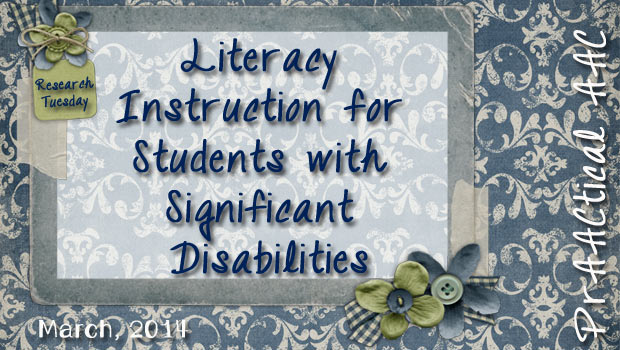
We all remember certain ‘firsts’ – your first bike, your first plane ride, your first car. One of my memorable ‘firsts’ is the first book I was ever given that was ‘just for me.’ I have fond memories of lazy summer afternoons with The Wishing Well, one of the Alice and Jerry basal readers. I may have broadened my library since that was given to me for my 4th birthday, but it still sits on my shelf and just paging through it brings back memories of being transported to another world. We can hardly imagine what life would be like without books. Reading brings us more than information. It allows us to explore, escape, relax, and dream. What must it be like to be deprived of the chance to learn and enjoy the printed word? Sadly, that is the reality for too many children and adults with AAC needs. In... [Read More...]
February 19, 2014
by Carole Zangari -
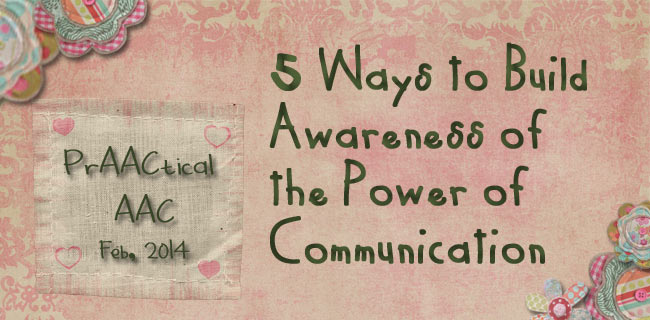
Awhile back I helped a graduate student clinician lead a session with some children who do not yet have AAC systems in place. Communicating with pictures is hard for them and doesn’t yet make sense. They haven’t connected the dots to see that when they use these picture-based materials, they can influence the environment in a way that makes their lives more interesting and fun. Our first step was to help them begin to understand that they could control aspects of their environment. Here are some things we did to help the AAC learners feel the power of communication. 1. Made communication easy: Talking switches and sequential communicators are great ways for learners to get a big payoff with little effort. In classrooms where there was no functioning technology, we used free apps for mobile devices and paper-based communication boards. 2. Made the response big and fun: Think silly,... [Read More...]
February 5, 2014
by Carole Zangari -
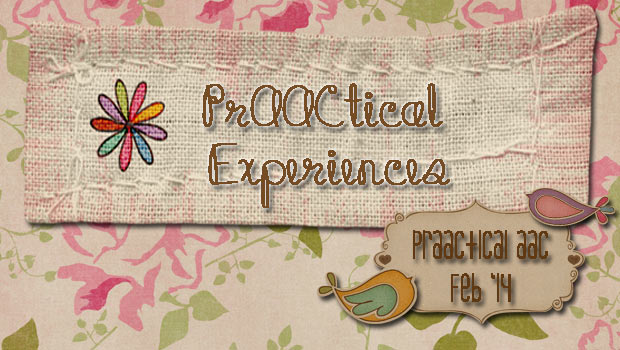
What do you wish you had known when you started providing AAC services? Awhile back, we posed this question on our Facebook page: “What are two things you wish you had known when you started providing AAC services?” The prAACtical responses got us thinking. Take a look. “The families need just as much training as the kids do.” Yup, and we’ll add something else to that. WE need training, too! We expect so much of ourselves, which is fine, but we also need administrators, agencies, and colleagues to realize that it takes a lot to keep up with changes in the science and technology. That doesn’t come cheap or easy. “Don’t be afraid to ask others in the field. They are so helpful for problem solving.” We couldn’t agree more. Most AAC professionals we’ve met have been incredibly supportive. Reach out to others in your area, through social media, and at... [Read More...]
January 27, 2014
by Robin Parker -
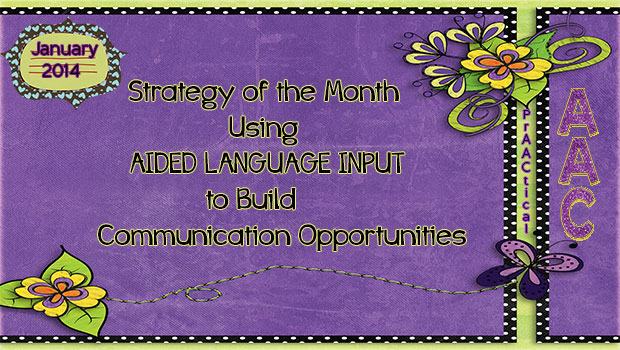
We can not write, speak or do enough Aided Language Input (ALI). If we expect learners to speak AAC, we must speak AAC to them. It is difficult enough to learn a language and imagine if no one spoke it to you in the language you were expected to speak…But there are so many more reasons to do ALI. Aided Language Input (ALI) belongs in the context of communication opportunities. It is modeling AAC style. Once we model a target language concept AAC style, then add the wait and signal strategy, the learner then knows it is their communicative turn. Especially if you wait with the raised eye brow signal. They often will take their turn expressively. But, if they do not take the communicative opportunity to take their turn, there are gestural, visual, verbal, and physical prompts that can be implemented. In other words, they can make use of... [Read More...]
January 13, 2014
by Robin Parker -
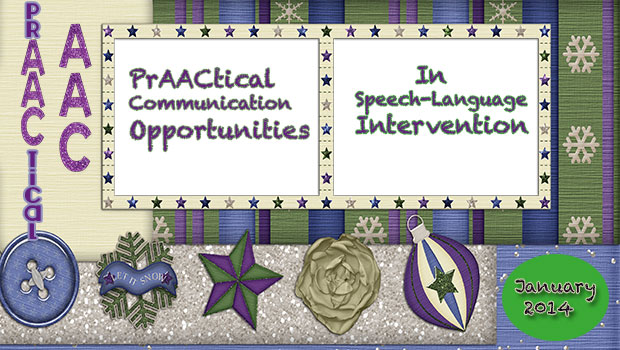
Planning for communication opportunities in every aspect of speech-language therapy helps ensure productive use of time and effort for both clinician and learner. It is not enough to talk to a student, it is not enough to provide fun activities without lots of opportunity for active participation and more specifically communication initiation. Another word for communication initiation/opportunities is communication temptations. Communication temptations are structured situations designed to entice a variety of specific communication functions or semantic relations (Wetherby, 1988). There needs to be lots of times where there is targeted modeling and then a specific, obvious reason for the learner to be the initiator of communication. A temptation to communicate. Take a look at this sample therapy session for frequent and multiple communication opportunities. Please let us know a favorite or creative communication opportunity that you use. PrAACtical Considerations Meaningful AAC Goals– All quality speech-language intervention sessions start with meaningful... [Read More...]
December 14, 2013
by Robin Parker -
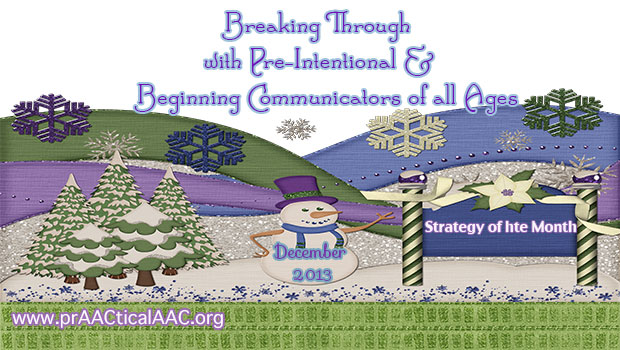
We are thinking a lot about emerging-intentional and beginning communicators. Even within these categories it seems there are sub-categories. We have a subset of learners who seem difficult to engage. They do not often respond to communication initiations by others. They can be content looking at small items or through self-stimulatory behaviors. These learners can get “communication” overlooked in class, in intervention, and at home because they can be quiet and subdued a lot of the time. They can be prompted through activities and events without difficulty but they often do not get to be communication initiators. And without a lot of practice initiating, it is hard to improve. You may hear or think these things about the learner: She does not like anything He is in his “own world” He does not care what he gets It seems like she can not hear She does not look at what... [Read More...]
December 7, 2013
by Carole Zangari -
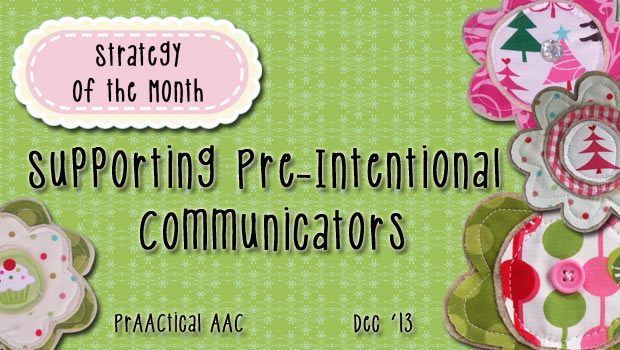
Scene 1 Alex looks at the picture symbol choices placed in front of him and knocks them to the floor. Simone looks distressed while she waits for her lunch and whines as she watches her classmates eating. Jason smiles engagingly and rocks enthusiastically when his favorite aide enters the room. Kyra takes a picture from her PECS book and begins to chew on it. Scene 2 “He can’t even make choices. I’m not even sure what he wants.” “She really doesn’t communicate.” “He doesn’t mean anything by it. He does that all the time.” “She needs hand-over-hand prompting for everything.” Great kids, caring professionals. Ineffective communication. This month, we focus on ways to support children and adults at the earliest stages of communication. It isn’t easy trying to figure out how to provide effective SLP services to individuals who are not yet sending messages intentionally. Communicators at the pre-intentional level are... [Read More...]
November 25, 2013
by Carole Zangari -

As any experienced AAC professional will tell you, people who are learning to use AAC systems don’t produce as much verbal output as their speaking peers. And, every once in awhile, we run into an AAC learner who communicates VERY infrequently even though they are capable of doing more. They’re often described as shy (perhaps) or stubborn (cringe! shudder! clench teeth!), but, in our view, their reluctance to communicate is probably related to a few other things. We generally don’t like to do things that are difficult for us, particularly if the pay-off is not in proportion to the effort, or if there are insufficient supports. If the learner has had a history of being unsuccessful or associates communication with a high level of effort, it makes sense that they are not rushing to interact with us. It doesn’t always pay to rush things. Sometimes we get better outcomes by building... [Read More...]
November 21, 2013
by Carole Zangari -
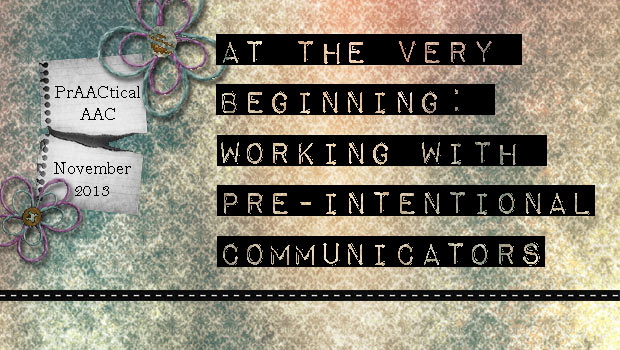
Recently, I had the opportunity to work with a first grader who was able to do many things: flash a dazzling smile, grab and hold onto materials on his laptray, vocalize loudly, visually track peers as they moved around the classroom, reach and take a toy that was offered to him, and laugh in such an engaging way that two girls immediately went to his side. What he DIDN’T do, though, was communicate purposefully. How do you address the learning needs of a 7-year-old who is not yet communicating with intent? Here are some initial thoughts. Getting him to learn to communicate purposefully, frequently, and in a way that is obvious (not subtle) is Priority #1. The way we typically approach this is to work with the team (teacher, OT, PT, aide, family) to decide on a motor movement that he can do, and agree to shape that into a... [Read More...]
October 7, 2013
by Robin Parker -
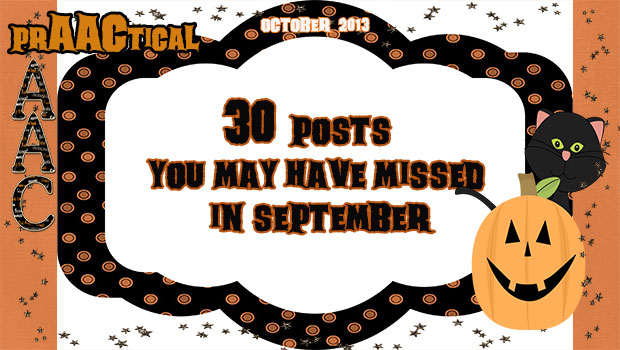
Strategy of the Month Infusing Literacy Learning Opportunities into AAC Therapies AAC & Literacy: Setting the Stage Literacy Lessons for Beginning AAC Learners Literacy for Everyone with Adapted Books PrAACtical Thinking PrAACtical Resources: A Look at the NJC The PrAACtical Power of Contrast 31 Posts You May Have Missed in August Literacy: Cookies & Core 5 Things to Love About the SETT Framework 10 Tips to Encourage Love of Literacy 5 Easy Ways to Add Authentic Writing Experiences to Your AAC Therapy AAC & Dinosaur Apps for Literacy & Language 5 AAC Strategies and the Use It of Loose It Philosophy 10 AAC Intervention Apps We Can’t Live Without 5 Things to Consider About Prompts in Teaching AAC Loving Literacy in AAC Keep Calm & Write ON.. fro All Writers Thoughts on Involving Our Clients in AAC Vocabulary Selection Presuming Competence & Teaching AAC 5 reasons We Don’t (Typically) Use... [Read More...]









